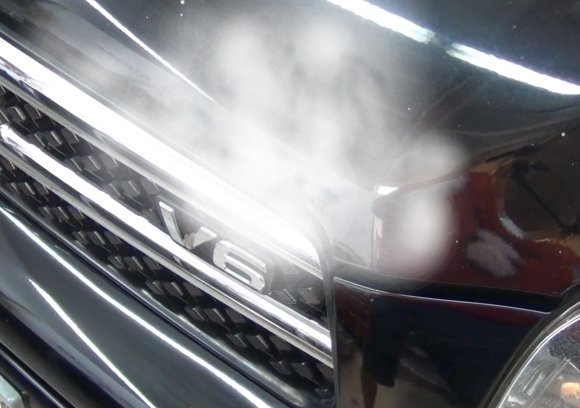This morning I drove to work, and kept my eye on the heat meter. It got hotter than normal range within 5 miles, and I pulled over. The overflow tank was pouring coolant out from under the cap. I waited for it to cool down and drove home.
I noticed that the radiator fan was never on, even in the red temperatures, so I figured the fan failed, which caused it to overheat, which caused the tank to boil over. This had probably happened before without me noticing, which was why the tank was empty?
So I looked at the cooling fan relay. With the relay out, I can short out the switch terminals and the fan spins, so the fan and switch wiring is good. With the ignition on, there's 12 V on the coil, but the switch wasn't closing. So I bought a replacement relay.
After putting that in, nothing changed. I realized that although one side of the coil is at 12 V, the other side gets pulled up to 12 V as soon as I put the relay in, so I guess the sensor pulls the relay terminal down when it's hot to send current through the coil? I measured resistance from the sensor connector, and it looks like one terminal is grounded.
So I also bought a new sensor, but I haven't put it in yet. I am hesitant because it will let all the coolant run out and I'm not sure how to make sure it's filled back up without air bubbles.
I measured the resistance of the two sensors, though, and I'm not sure the sensor is bad, either. The brand new sensor at room temperature is 3.2 kiloohm. The old sensor in a hot engine is 270 ohm.
Also, while hot, if I plug in the connector to the sensor, I hear something moving briefly near the top of the engine. When I disconnect it, it moves again. So it seems like the sensor is affecting something, which also makes me doubt that it's bad.
So now I'm not sure what to do. If I force the fan on, the temperature doesn't go too high, so I think I can drive it like this temporarily. I filled up the tank with coolant and drove around some while getting parts, and the overflow tank is still mostly full, so I don't think there's a huge leak, if any.
Also, the low coolant light has never gone out, even with coolant in the reservoir, even after I shook it and tapped it to try to get rid of bubbles.
What's my next step? I think maybe the coolant temperature sensor doesn't connect directly to the relay, so I'm not sure if I understand the circuit or where the problem might be. I wish I had a schematic.
SPONSORED LINKS
Tuesday, November 11th, 2008 AT 3:23 PM



